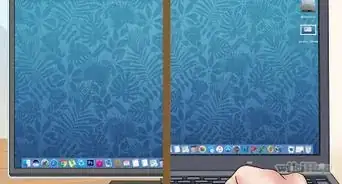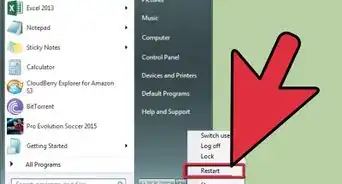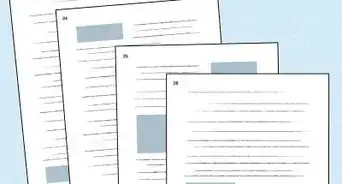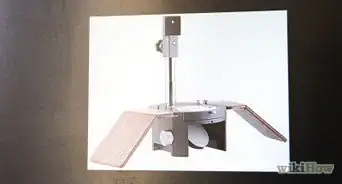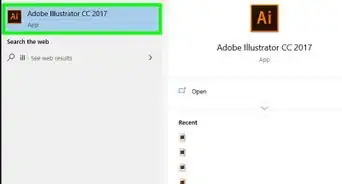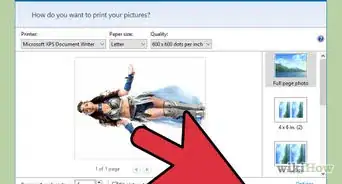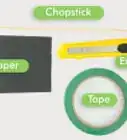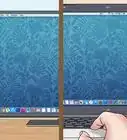This article was co-authored by wikiHow Staff. Our trained team of editors and researchers validate articles for accuracy and comprehensiveness. wikiHow's Content Management Team carefully monitors the work from our editorial staff to ensure that each article is backed by trusted research and meets our high quality standards.
There are 7 references cited in this article, which can be found at the bottom of the page.
This article has been viewed 111,878 times.
Learn more...
A pen stylus is a great way to improve your accuracy when drawing or writing on your touch screen device. Try making your own stylus at home from basic materials. If you have a metal pen on hand, simply remove the ink tube and replace it with a cotton ball. Alternatively, use aluminium and foil to turn any pen into a stylus. These methods are quick and easy, and work on any device that has a touch screen.
Steps
Using a Metal Pen
-
1Remove the ink tube from a pen that has a metallic body. Unscrew the mouth of the pen to reveal the ink tube. Pull out the ink tube and the spring from the body of the pen and then screw the pen back together. Throw the ink tube straight into the trash once you remove it to stop it from leaking on your furniture.[1]
- It is important to use a pen with a metallic body, as this conducts the electrical charge from your hand which makes the stylus to work.
-
2Push a little cotton ball into the tip of the pen. The cotton ball helps to conduct the electrical current and gives the stylus a padded pointer. Roll up a little cotton ball and push it into the nib of the pen. Try to push as much of the cotton ball as you can into the pen so that it doesn't come loose when you try to use the stylus. [2]
- If you don't have a cotton ball, use a small piece of cotton fabric.
Advertisement -
3Trim off any excess cotton ball that is hanging out of the nib. This makes the stylus easier to use and makes its touch more accurate. Leave about 2 millimetres (0.079 in) of the cotton ball hanging out of the pen so that the tip of the metal pen doesn't scratch your screen.[3]
- If the cotton ball falls out or gets pushed into the pen over time, simply push a little more of the cotton ball into the nib of the pen.
-
4Use your pen stylus in the same way that you would use your finger. Press the cotton ball down on the screen to activate it. Move the stylus around the screen to navigate around the device. Keep spare cotton balls on hand to refill your stylus in case it falls out with usage or in storage.[4]
Creating a Stylus with Aluminium Foil and Cotton
-
1Unscrew the pen to remove the ink tube. In order to make this stylus, you need a pen that can be unscrewed. Remove the spring and ink tube from inside the pen and then reassemble the pen.[5]
- Keep the small inside parts of the pen away from children, as they can pose a choking risk.
-
2Cut the middle of a Q-tip on an angle. Estimate where the middle of the Q-tip is and then chop it in half on a sharp angle. This creates a pointy end on the plastic part of the Q-tip which makes it easier to insert into the pen.[6]
- Throw 1 half of the Q-tip into the trash, as it is not needed for the stylus.
-
3Poke the pointy end of the Q-tip into the tip of the pen. Leave the cotton portion of the Q-tip and about 5 millimetres (0.20 in) of the plastic handle out of the pen. Don't worry if the Q-tip is a little loose, simply hold it in place for now.[7]
-
4Secure the Q-tip in place with a piece of tape. Wrap the tape around the plastic portion of the Q-tip and the mouth of the pen so that it stays in place when you are using your stylus. If the Q-tip still feels a little lo0se, simply wrap another piece of tape around it.[8]
- Both sticky tape and masking tape work for this task. Avoid using washi tape, as this doesn't tend to be as sticky.
-
5Wrap a 9 cm (3.5 in) square of foil around the Q-tip and the neck of the pen. Cut out the aluminium foil with a pair of scissors. Wrap the square tightly around the plastic portion of the Q-tip and around the neck of the pen. The aluminium foil helps to transfer the electrical current from your hand to the tip of the Q-tip.[9]
- Don't cover up the cotton portion of the Q-tip, as this helps to prevent the screen from getting scratched.
-
6Moisten the tip of Q-tip with water each time you use it. Wet your fingers and then dab the Q-tip with your damp fingers. This small amount of water helps to conduct the electrical current and makes the point of the stylus more accurate. Use your homemade stylus to navigate your way around your device. If it loses its accuracy, simply place a little extra water on the end of the Q-tip.[10]
- Avoid soaking the Q-tip in water, as this can leave drops of water on your screen.
Community Q&A
-
QuestionI put water on the end of my stylus and use it on my phone screen, but nothing happens. Please help.
 VerinTop AnswererMake sure that the foil is in contact with the tip, and that you are touching the foil at all times. Remember, it's your body's natural electric field that allows you to interact with your tablet screen, and that the foil and wet tip are conducting that field.
VerinTop AnswererMake sure that the foil is in contact with the tip, and that you are touching the foil at all times. Remember, it's your body's natural electric field that allows you to interact with your tablet screen, and that the foil and wet tip are conducting that field. -
QuestionIs it important to use only cotton swabs or we can use cotton?
 Community AnswerYou can use cotton balls if you would rather, they'll work just as well.
Community AnswerYou can use cotton balls if you would rather, they'll work just as well. -
QuestionCan I use a pencil as a stylus?
 Belle K.Top AnswererNo. The eraser is far too rough for the screen and will just dirty it up. The graphite tip will just destroy the screen.
Belle K.Top AnswererNo. The eraser is far too rough for the screen and will just dirty it up. The graphite tip will just destroy the screen.
Things You'll Need
Using a Metal Pen
- Scissors
- Cotton ball
- Pen with a metallic body
Creating a Stylus with Aluminium Foil
- Scissors
- Q-tip
- Sticky tape
- Water
- Aluminium Foil
References
- ↑ https://youtu.be/4tf2lm5RgCU?t=14
- ↑ https://youtu.be/4tf2lm5RgCU?t=28
- ↑ https://youtu.be/4tf2lm5RgCU?t=53
- ↑ https://youtu.be/4tf2lm5RgCU?t=53
- ↑ https://www.cnet.com/how-to/diy-the-2-minute-stylus/
- ↑ https://youtu.be/8-rPLMErdFU?t=59
- ↑ https://youtu.be/8-rPLMErdFU?t=65
- ↑ https://www.cnet.com/how-to/diy-the-2-minute-stylus/
- ↑ https://youtu.be/8-rPLMErdFU?t=96



